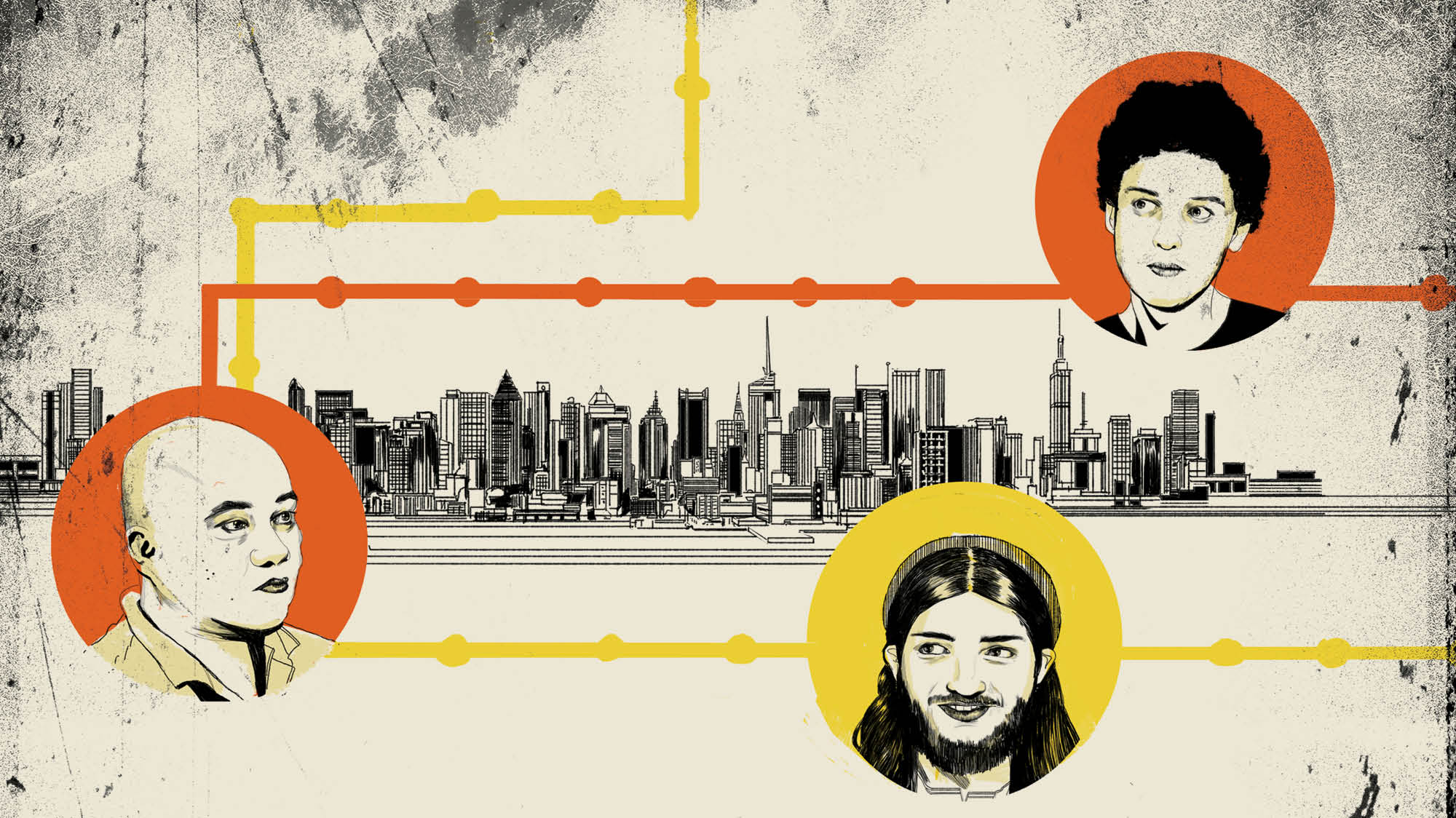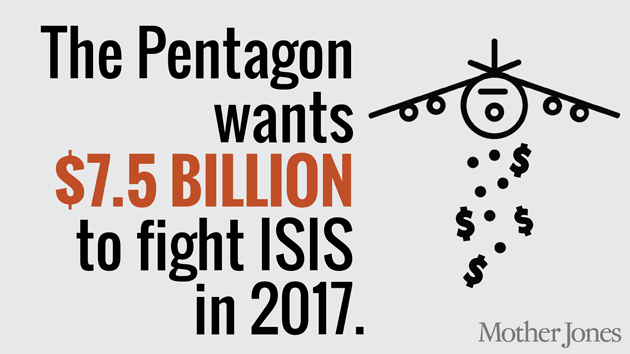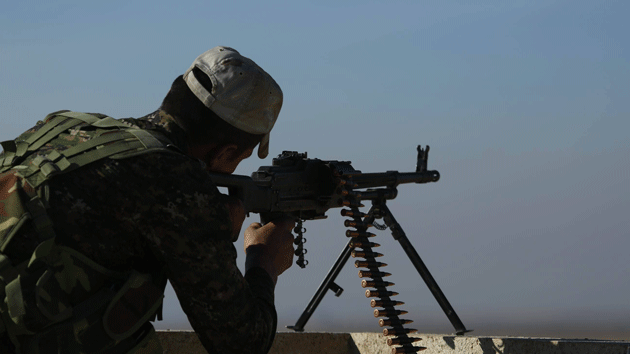At first glance, Abdulrahman el-Bahnasawy, a Muslim kid from the suburbs of Toronto, seemed an unlikely jihadi. A soft-spoken 18-year-old with delicate features and thick curly hair, he had rejected Islam at 15, announcing to his parents, conservative Egyptian immigrants, that he was now an agnostic. This, he would write later, was just one of the many troubles he caused his family: After he discovered weed at 14, his terrified parents moved with him and his older sister to Kuwait. There, lonely and bullied in school, he began to take every drug he could get his hands on. He attempted suicide several times. Foreshadowing the bipolar disorder and schizophrenia he would later be diagnosed with, he would sit on the toilet in his parents’ house for hours, huffing butane and hallucinating, conversing with “Hamtaramo,” an imaginary pilot who spoke to him through the radio. “He was,” Bahnasawy wrote later, “like a friend.”
Back in Toronto, after he did a stint in rehab, his family put him in an Islamic school where he soon turned to the Koran with the same ravenous enthusiasm he had previously reserved for drugs. At his parents’ house, he haunted jihadi chat rooms that served as de facto recruitment centers for disaffected young Muslims yearning for something different and purer than their lives in the West. “I realized Islam would fix all the problems in society or the world in general,” he wrote later, “and that its lifestyle would have prevented the life I lived.”
Online, he met a hardened fighter who went by the nom de guerre Abu Isa al-Amriki, “The American.” Despite his sobriquet, The American was a Sudanese national living in Syria, and according to the Pentagon, he was a member of ISIS’s secretive external operations branch, devoted to building a global network of homegrown terrorists to challenge the enemies of the caliphate on their own turf. After Bahnasawy proved his commitment with a donation of $500 and some cellphones for the brothers in jihad, Amriki began to give him assignments, small tasks like vetting other new recruits and hacking into the cellphones of members to discover if they were undercover law enforcement—in one case, when Bahnasawy determined a recruit was a cop, he doxed him, releasing his photo to a chat group with an admonishment to kill him.
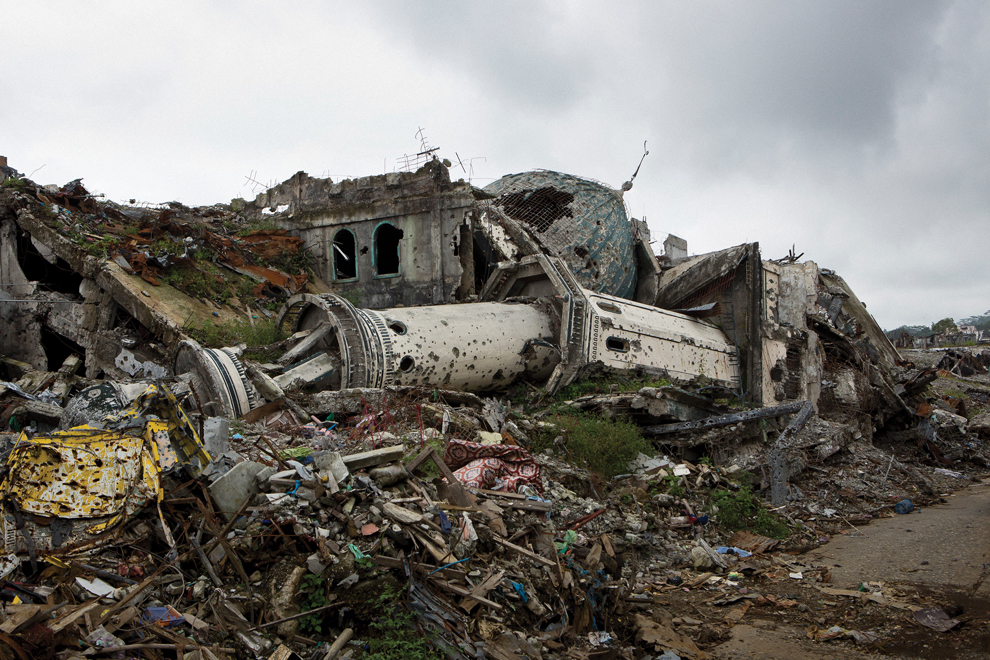
Fighting between ISIS militants and Philippine troops in 2017 devastated the city of Marawi.
David Maurice Smith
Another recruit Bahnasawy met online was an 18-year-old much like himself, a Muslim raised in Colorado named Talha Haroon who sometimes went by the screen name “Kill Kuffars,” or “Kill Infidels.” Haroon’s interest in joining ISIS might have been personal revenge: In 2007, his father, Haroon Rashid, was deported from the United States following a conviction of misdemeanor assault (that was later overturned) and, in an unrelated incident, terrorism charges that were later dropped. In 2014, Haroon joined his father in Pakistan, where, he told Bahnasawy, he linked up with the Taliban and hoped to fight with ISIS. A photo published by IBC English shows a long-haired, beatific young man barely old enough to vote, wearing a white shalwar kameez, holding a white cockatiel, and raising his right index finger, a common gesture of support for ISIS.
They agreed. But Bahnasawy didn’t want to hit Canada. As he later explained, the country had recently stopped airstrikes, “and it didn’t make sense to transgress…against them in such a way.” The United States, however, would be a perfect target. In early 2016, Amriki offered the two 18-year-olds the opportunity to demonstrate the depths of their commitment. ISIS was being pressed on all sides by an alliance of countries that included the United States, France, Iraq, and Canada, Bahnasawy’s home, and to show ISIS’s capacity to fight back, the organization’s leadership was planning a series of worldwide assaults for Ramadan that summer. Would Bahnasawy and Haroon team up to carry out a suicide attack?
Bahnasawy proposed they board intersecting lines of the New York City subway with rifles and ride in synchrony, killing until they reached their rendezvous. If they were still alive, they would escape to their car for a final drive-by on Times Square. Haroon liked the plan, with one addition: To cause maximum carnage, he suggested they build explosive vests. “Then once we reach the second station get off and start killing on that station as well,” he wrote, “and if we get trapped we let the vests go off. But we need to make sure to do it on a very busy day.” Most importantly, he cautioned, “we kill all in the train regardless of who.” And, he added, “remember do not stop shooting even if u see women or kids. No mercy is rule one.”
Their plan had some potential hiccups that might have been funny in another context: The pair failed to account for subway delays; they placed a lot of faith in their ability to find parking near Times Square; they didn’t start looking for a summer cabin rental in upstate New York—for use as a bomb-building and “training” site—until about two weeks ahead of time, when they found to their dismay that campsites were all booked.
But the biggest issue was that neither of them had much money. In Pakistan, Haroon was selling his personal possessions to fund the flight to America. In Canada, Bahnasawy had ordered 40 pounds of hydrogen peroxide, a key precursor in making bombs, but he ran out of cash.
Then, on April 22, 2016, disaster struck: “The American,” who had brought the two co-conspirators together, was targeted by a US-backed airstrike that blew up his apartment east of Aleppo, Syria, killing him and his Australian wife, who had recruited war brides online. To replace him, Bahnasawy brought in another ISIS sympathizer from Ohio, a shadowy man he’d met on the internet—let’s call him Rahman—who agreed to meet the two aspiring terrorists in New York to help complete the plot. “[T]he path of jihad is something very rare in this century,” Haroon wrote excitedly to Rahman, “and it’s a huge blessing for us to be a part of it.”
The final step was to cobble together enough cash to buy guns and the remaining ingredients for explosives. Ramadan was now less than a month away. Luckily, “The American” had left Bahnasawy a list of financiers good for small donations. The best of them, Bahnasawy determined, was a British doctor named James Klein. Klein was, in fact, a Filipino orthopedist named Russell Salic who had been funding terror plots for years—he kept his real name secret from the others, at least at first, as a security precaution. But from Salic’s “James Klein” Facebook page, Bahnasawy could see he was the real deal, even if he wasn’t who he said he was: The month before, the doctor had published a picture of a militant holding a severed head, with the caption, “I didn’t know they have it also in South East Asia. Amazing. Ya Allah.”
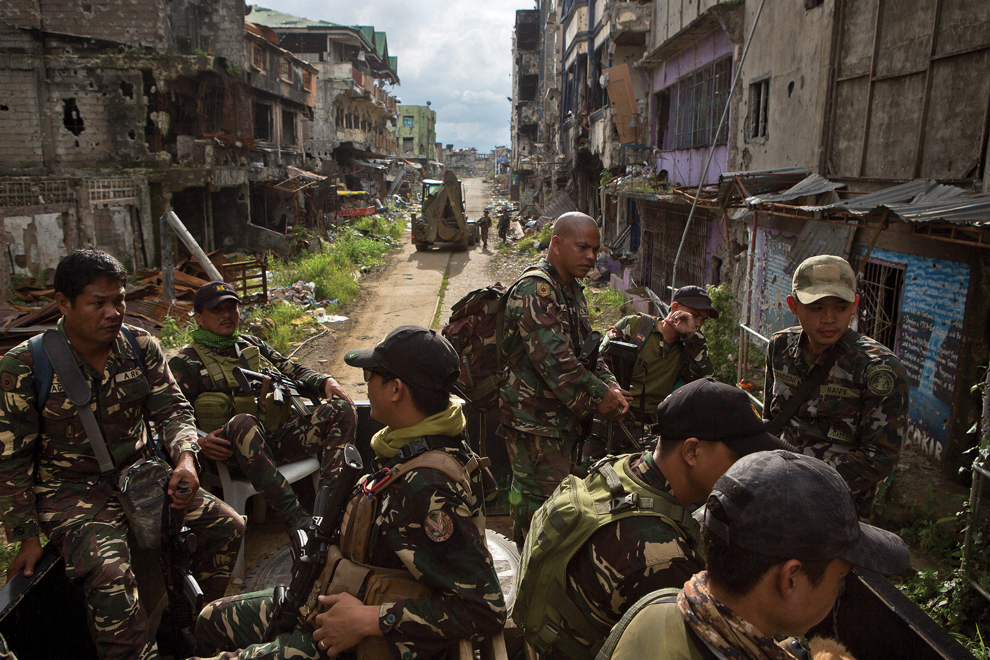
Members of a military joint task force work to clear the main battle area in Marawi of explosives.
David Maurice Smith
Salic wasn’t scared to communicate or send money openly, he explained to his teenage conspirators, because he was in a country that was “a breeding ground for terrorists…hahahaha”: the Philippines. The country, he wrote, was a place with a uniquely welcoming environment for jihadism. And indeed, in the months to follow, ISIS-linked fighters would raise the black flag in towns and cities in the southern Philippines, prompting President Rodrigo Duterte to send in tanks and helicopters.
During the tumult of the last two years, Bahnasawy and Haroon’s plot has mostly been forgotten, as has the war in the southern Philippines. But amid President Donald Trump’s talk of defeating ISIS across the globe, it is telling for two reasons: It shows how disaffected young men, whether teens in America and Canada or impoverished youths in Southeast Asia, are being drawn to the cause. And it reveals that the Philippines, like Iraq and Afghanistan before it, is a place where a scorched-earth campaign may radicalize factions for decades to come. Facing extradition to the United States, Salic could head to trial in the next year, and observers hope testimony will reveal whether ISIS’s presence in the Philippines is the next big threat poised to come home to roost in America.
“[B]ro we need to rise up,” Salic wrote, enthusiastically agreeing to finance Bahnasawy and Haroon’s massacre. The two boys didn’t know, as a Philippine military spokesman would later tell Reuters, that Salic had allegedly been treating wounded ISIS militants in clandestine camps, nor did they know his real identity. But he was candid about his hopes for their Times Square attack. He looked forward to the destruction of a place that offered so much evil temptation, or fitna, to good Muslims like themselves. “The fitna,” Salic wrote, “is oozing there in the big apple.”
The Philippines—a former US colony and one of America’s longest-standing allies in Asia—doesn’t seem to fit in with ISIS’s other breeding grounds in Africa and the Middle East. Home to 100 million people, about 5 percent of whom are Muslim, the country is an ever more important pivot of the world economy, with extensive US telecommunications interests and a long history of military cooperation with the United States. Since becoming president, Trump has deepened ties with Duterte, selling weapons and contributing logistical military support to efforts to quell ISIS militants in the south. Many observers have slammed Trump for ignoring Duterte’s abysmal human rights record—thousands of suspected drug dealers and users have been killed in extrajudicial executions. But other Filipinos admire Duterte for these killings, and he has earned loyal support for presiding over a massive spike in the country’s economy. Last year, foreign direct investments in the Philippines reached a record high of $10 billion. Growth, infrastructure spending, and GDP are up, leading Bloomberg in January to call the Philippines one of the “decade’s economic stars.”
But prosperity hasn’t extended to the southern island of Mindanao, home to the vast majority of the country’s Muslims and the birthplace, in 1980, of Russell Salic. About the size of Cuba, Mindanao is a visual feast of beautiful highland mountains and beaches, populated by about 5 million Muslims and 15 million Christians who live in mostly peaceful but occasionally tense cohabitation. It was in and around Marawi, the largest city in Mindanao’s Muslim autonomous region, where ISIS-aligned rebels waged a five-month insurgency in 2017, burning churches, killing Christians, and sending hundreds of thousands fleeing. Inequalities between the religious groups, and between Filipinos from Mindanao and the rest of the country, are stark. Sixty percent of residents in the autonomous region live below the Philippines’ poverty line of about $2,000 a year. More than 40 percent of the population does not have access to clean water, and just 27 percent have adequate plumbing.
For years, experts and officials fretted over the prospect of these schisms providing fodder for jihad. The southern Philippines is, after all, in some ways a perfect laboratory for designing anti-American sentiment. The first American-led war against a Muslim insurgency took place shortly after 1898, when the Spanish ceded the islands to the United States after the Spanish-American War. The Spaniards signed over not only the northern part of the Philippines—which they had spent centuries conquering, Christianizing, and Latinizing—but also the Muslim south, which had maintained a stubborn resilience. The first American war parties that ascended to the misty highlands of Mindanao found themselves in hostile country, surrounded by a bewildering array of fiercely independent Muslim tribes—called “Moros,” because the Spanish insisted on referring to them as Moors—determined to resist the infidel invaders.
It was in the Philippines that Americans first encountered Muslim suicide attacks, carried out by juramentados, sworn to die for the faith and armed with razor-sharp krises, who often took volleys of bullets—and American lives—before going down. In 1906, Leonard Wood, a governor general of the Philippines who had presided over the slaughter of entire Moro communities, would write to his subordinates, “Work of this kind has its disagreeable side, which is the unavoidable killing of women and children; but it must be done, and disagreeable as it is, there is no way of avoiding it.”
All of this sowed a bitter harvest. The 1960s through the 1980s in Mindanao saw a series of rebellions by a succession of Moro separatists, which further splintered into a confusion of Islamist insurgencies in the 1990s. The central conflicts all came down to land and freedom: The postindependence Philippine government had continued the American policy of settling Christian Filipinos and foreign corporations on Muslim lands, until the Moros were confined to a small portion of the territory that had once been theirs; many Moros felt Manila treated them like a cow to be milked for soil and resources, rather than as equal partners in the republic.
Russell Salic was raised in the vicinity of Marawi, an almost exclusively Muslim city of about 200,000 on the shores of an exquisite lake. His generation of Moros grew up marinated in the lore of resentment and revolution, and the radicalism that simmered in the Philippines throughout the 1990s and 2000s—Ramzi Yousef hatched what would become the 9/11 plot from an apartment in Manila, and the terrorist pirates of the Abu Sayyaf group kidnapped foreigners throughout Southeast Asia—offered riveting examples of insurgency to any rebellious kid with a grudge.
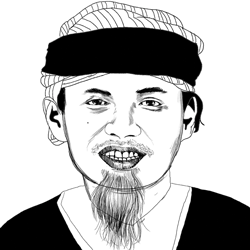
Abdullah Maute
Illustration by Nicole Rifkin
ISIS was the latest variation on this theme. In 2014, a pair of charismatic extremist preachers who saw in ISIS’s bloody universalism a chance to win freedom for Mindanao swore allegiance to the terror organization. Omar and Abdullah Maute were two brothers in their 30s from a powerful family with strong roots in the Moro Islamic Liberation Front. They had attended university in Egypt and Jordan and became radicalized by the failure of peace negotiations between Moros and the Philippine government.
At home, the brothers amassed a guerrilla army numbering over 1,000 and began laying the groundwork for a caliphate in Mindanao. Their family had grown rich from municipal construction work, but they drew their recruits from the ranks of the region’s poor, highlighting the rampant inequality and poverty of the Philippine republic. Their situation was complicated when a fellow Mindanaoan became president in 2016—Rodrigo Duterte, raised as a Christian in the island’s southeast. Though Duterte had offered overtures to Moros, he had also made it clear that he would not brook rebellion. If terror emanated from the island, he said, he would be harsh, “as harsh as I can ever be.” But that didn’t stop the Mautes, or, allegedly, Salic.

Omar Maute
Illustration by Nicole Rifkin
Salic worked as an orthopedic surgeon in the northern Mindanao city of Cagayan de Oro, and he’d been sending Western Union donations since the mid-2010s to jihadi plots in Bosnia, Lebanon, and Palestine. But in April 2016, according to witnesses, he allegedly stepped up his involvement when he visited the Maute family stronghold in Butig, an impoverished city of 19,000 people. Located in an outlying neighborhood, the compound was surrounded by foxholes and overlooked by a three-story watchtower.
A few months prior, the Mautes had led their fighters in a bloody and ultimately unsuccessful attempt to take over all of Butig, forcing the national army to chase them out with helicopter gunships. Now they were training more soldiers, often from the rebel groups and private armies controlled by powerful local families.
On April 4, a dozen men left the compound and drove to a sawmill where the Mautes often bought supplies, and where—the brothers suspected—the workers had informed on them for the Philippine army and the country’s equivalent of the FBI. Six sawmill workers were cutting lumber when men carrying rifles tied their hands, loaded them into the truck, and brought them back to the compound.
They left the workers tied up; Salic, the survivors would later testify, was on the premises cleaning firearms during their captivity. He was smiley and plump, unlike the gaunt, serious soldiers. According to court documents, he ordered the guards to prepare food and coffee for the captives, and to watch them carefully to make sure they did not escape. (Salic denies he was ever at the compound.)
The captives later testified that their guards—in an echo of the messages then coming out of the caliphate itself—had told them they were seized to show that ISIS in the Philippines hadn’t been conquered. On the fourth day of their detention, the guards dressed the sawmill workers in Gitmo orange and took their pictures. To “prove to the world that theirs is a legitimate ISIS organization,” the guards told the captives, they were going to behead them. The sawmill workers waited for two agonizing days, until the fighters returned for them.
A video posted on a jihadi site showed what happened next. A line of black-clad militants holds two of the terrified sawmill workers, Jaymart Capangpangan and Salvador Janubas, on their knees. One fighter chants in Arabic and then nods to his confederates, who force the men down, grabbing their heads by the hair. Janubas’ executioner is clearly inexperienced; it takes him nearly 30 excruciating seconds of sawing through bone and cartilage before he is able to remove the head. The fighters hold up the severed skulls, the faces gazing glassily at the camera, and place them faceup on the decapitated workers’ backs. “Allahu akbar!” they shout. God is great. Then they blindfold the survivors and dump them, shaken but alive, in a vacant lot and drive off. According to the state prosecutor, it was these severed heads that “James Klein,” Salic’s British alias, had posted about so approvingly online.
In mid-May, one month after the sawmill beheadings, Salic went to a Western Union across the street from the hospital where he worked in downtown Cagayan de Oro and sent $423.80 to the conspirator in Ohio, Rahman, asking him to keep the identity on the slip—his real name—secret.
By this time, Bahnasawy had finally managed to find them a cabin outside the city, Haroon was making plans to come meet him, and Rahman was in New York, ready to join them for the suicide assault on the subway. Salic, back in the Philippines, was elated. “Allahu akbar! Allahu akbar!” he crowed via the encrypted messaging app they used to communicate. “Keep safe my brother.”
Messages flashed back and forth across the globe, braggadocious and bloodthirsty. “Looks like a perfect spot to hit them,” Haroon wrote, when he saw pictures taken by Rahman in Times Square. “We have to make an ocean out of their blood.” Perhaps, he wrote, they should “hit up a Jewish neighborhood” after the initial attack. Salic liked this idea. Noting Jews in Rahman’s pictures from New York, he wrote that “it would be a great pleasure if we can slaughter them.”
Meanwhile, back in the Toronto suburb of Mississauga, Bahnasawy’s parents suspected none of this. After a long delay on a mental health waiting list, they had finally managed to get him an appointment with a psychiatrist. As a surprise, they had planned a family road trip down to New Jersey just before the appointment—which Bahnasawy saw as the perfect opportunity to slip across the border “masked behind my parents back,” he wrote.
On May 21, the family left Mississauga, following the curve of Lake Ontario down past Niagara Falls and Buffalo. They crossed the border without incident; Bahnasawy watched as they sped through the granite hills, small farms, and rusting towns of upstate New York. They were headed, he texted Rahman, to Cranford, New Jersey—pick me up there. But when the Bahnasawys pulled into the parking lot of the hotel, they found themselves suddenly surrounded. Three cars boxed them in; 10 people dressed in black pulled an unresisting Abdulrahman out of the car. “We were so shocked,” his sister, Basma, later told CBC and the Toronto Star. Their mother thought her son was being kidnapped by gangsters and tried to pull him away from them. Only then did the agents identify themselves as FBI.
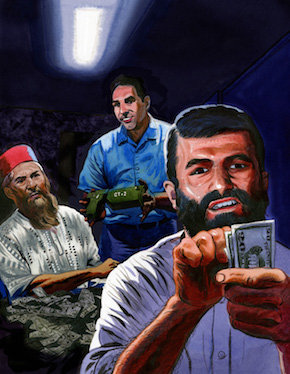
RELATED: The Informants
The family spent an anxious night without knowing what its youngest member could possibly have done in the eight hours since crossing the border. The next day they met with his public defender, who explained the government charges: conspiracy to commit acts of terrorism transcending national boundaries, conspiracy to bomb a place of public use and a public transportation system, conspiracy to provide material support and resources to terrorists, and so on.
“At one point, I didn’t even hear what she was saying anymore,” Basma recalled. In the Metropolitan Correctional Center in New York City, where FBI agents had locked up Bahnasawy, he learned that Rahman, the man from Ohio, had been an undercover FBI agent all along.
In his cell, Bahnasawy thought back to the moment when it all could have changed: Before his arrest, he had entered the secret code to decrypt the app channel he used to talk to the undercover agent, and it hadn’t worked. For a brief second, he would later write, he thought that perhaps this had been a sign from God, the most merciful, to back away from this plan and do something else with his life. But then he remembered he had written the code backward for security. He reentered it, the key turned, and about three weeks later he was in a New York correctional center, facing a possible sentence of life in prison.
For the next 18 months, the US government kept Bahnasawy’s arrest secret, the indictment sealed. The undercover agent Rahman lied to Salic and told him that the conspirators were silent because they were holed up in their cabin, building explosives.
At some point, Salic must have realized the plot had failed, but the bloody Ramadan 2016 campaign continued, as ISIS sympathizers throughout the world fanned out in an unprecedented spate of attacks in Turkey, Iraq, Yemen, France, Lebanon, Jordan, and Afghanistan. More troubling than the death toll, which reached into the hundreds, was the implicit message in the range of attacks—as a New York Times headline about a rampage in Bangladesh put it, “Bangladesh Attack Is New Evidence That ISIS Has Shifted Its Focus Beyond the Mideast.”
On June 24, Salic sent $426.30 to a young Malaysian who four days later attacked a Kuala Lumpur nightclub with a grenade, wounding eight. Police later found a Western Union record sent from the same store in Cagayan de Oro that had issued the transfers to the New York plotters. (Salic denies ever sending money to terrorists.)
Two months later, in August 2016, Pakistani security officials stormed the house of Salic’s and Bahnasawy’s 18-year-old co-conspirator, Talha Haroon, in Quetta, near the Afghan border. “They searched every nook and corner but could not find anything,” Haroon’s father told IBC English. “After they left, I realized that they took my son Talha Haroon with them.” It was November before he got a call from his child, now held near the capital in Islamabad. “Talha told me that he was badly tortured and even waterboarded during his illegal detention.”
But Salic was nowhere to be found. Mindanao, after all, as he had boasted, was basically lawless. It wasn’t until nearly a year after the arrest of his co-conspirators that Salic finally turned himself in, on April 7, 2017, after learning he was wanted by the US government.
In December 2017, I flew to the Philippines to try to interview Salic. He was being held in a Manila jail awaiting trial. As a result, he’d missed the Maute army’s dramatic siege of Marawi, which had been launched seven months earlier. Militants had succeeded in capturing and holding the city through October, and during those five months, fighting between the Philippine army—with logistical support from US special forces—and rebels had destroyed much of the area, killing 168 government troops and hundreds more rebel fighters, and displacing at least 200,000 civilians. I arrived in the immediate aftermath of the battle: Martial law had been declared, and the Mautes’ men were thought to be lurking in the forest. Text messages flew around saying they were going to attack the city again at any moment.
I met Lt. Colonel Samuel Yunque, a commander in the elite Scout Rangers who had marched his troops into the city on the fourth day of the battle and never left. We drove in convoy at top speed into the ruined metropolis, through blocks on blocks of blasted apartment buildings that recalled images from Aleppo or Stalingrad. What had once been a thriving market city was now blasted into rubble, filled with unexploded army bombs, many of them later refashioned by the Mautes into improvised explosive devices that still mined the streets. We walked past a mosque, cast down on its side like the victim of some terrestrial shipwreck. Rifles and grenades and helicopter-fired rockets had shattered storefronts. Behind a dump truck tipped over on its side, I saw a van with a bumper sticker that said, “Don’t follow me, I’m lost too. Follow ISLAM, the straight path.”
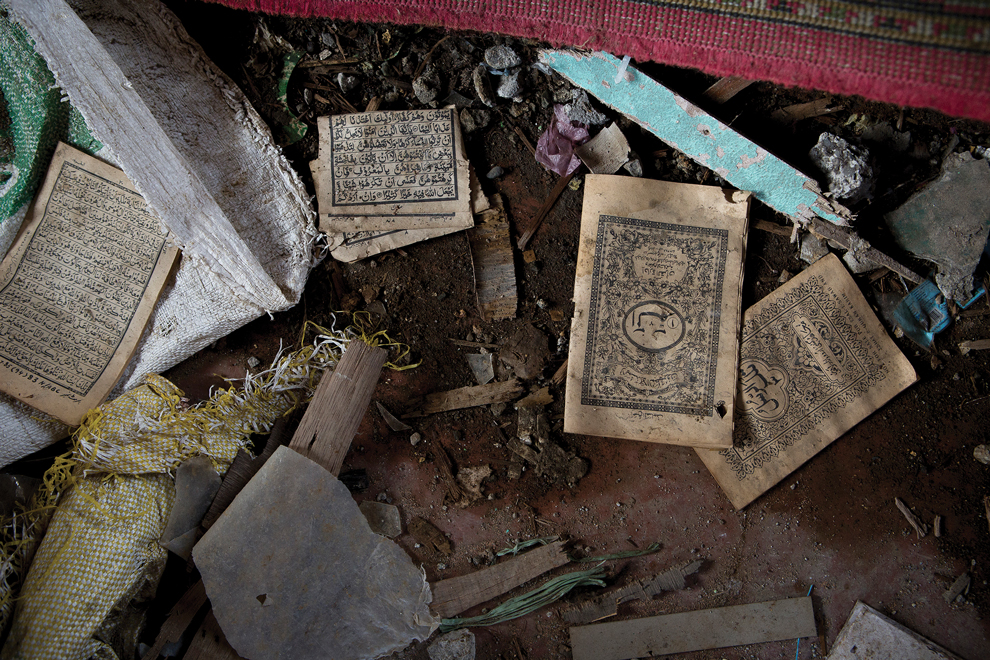
Pages from the Koran lay strewn on the ground inside a destroyed mosque in Marawi.
David Maurice Smith
We stopped in front of a townhouse. Yunque had fought his first engagement here, rescuing pinned-down soldiers from an ambush by the troops that Salic had allegedly accompanied in the sawmill beheadings. Yunque explained how the battle had gone: “inch by inch, house by house.” At a military hospital in Manila, I had met First Lieutenant Christopher Montecillo, who’d been wounded in fierce fighting. He had been leading his soldiers under cover of darkness when someone kicked a trip wire. Floodlights came on: They were in the “kill zone.” The four men in front of him died instantly in an explosion and hail of automatic fire—their bodies, burning, later showed up on a jihadi website. Terrified and unprepared, soldiers like Montecillo had resorted to scorched-earth tactics, pummeling the deserted city with grenades and airstrikes as they closed in on the Mautes. According to Amnesty International, Philippine army soldiers tortured some of their prisoners. After more than three months of fighting, they finally pushed the last Maute survivors back to a tiny perimeter, where Scout Ranger snipers hunted and killed the Maute brothers and Isnilon Hapilon, a notorious ISIS emir.
Yunque was grimly proud of his men: Despite their lack of preparation, he said, adjusting his sunglasses, and despite their lack of supplies, they had outperformed America. “In Raqqa, in Fallujah, in Mosul,” he said, “there’s an average of two years before a city is cleared. That’s with all the firepower of the US and the alliance and all the technology. Here in Marawi we don’t have that much capability, we were not fully trained in urban [warfare], but what we have is the fighting spirit of a Filipino soldier.”
Yet the idea that the insurgency was finished, as Yunque claimed, turned out to be wishful thinking. According to some estimates, at least 300 fighters had sneaked out of the besieged city to regroup, and this June, under the command of a new leader, they reappeared with even more fighters and clashed with the army in the southern province of Lanao del Sur, causing 11,000 civilians to flee.
Even more dubious was the suggestion that ISIS in the Philippines was somehow equivalent to ISIS in the Middle East. Before my arrival, everyone, from Singaporean government ministers to the Philippine secretary of defense, was saying the siege had been driven and supported by hardened foreign fighters, some—it was hinted—who had come by a sort of Syria-to-Mindanao pipeline. But while there were certainly foreigners there, most fighters were from the Philippines, Muslims from Mindanao or the islands to the south—and a lot were local children and teens.
As I walked through Marawi, I noticed that the graffiti on the battered walls was exuberant, strangely childlike: notes like “I <3 ISIS” and “I <3 Maute” scrawled on brick; an “isis” with hearts instead of dots.
Nasheeba Yusop, a woman about 20 years old who had been trapped in the city during the battle, told me that she had evaded fighters who were at most 15. Saripada Pacasum Jr., a leader of a volunteer ambulance corps known as the Suicide Squad, told me that inside the besieged city he had seen child soldiers so small “they almost had to drag their M14s.” Marawi, he reminded me, was poor and isolated, a product of stark inequalities, and rebel leaders had made good use of exploiting that situation. The Mautes had offered sign-up bounties of 50,000 to 100,000 pesos, about $1,000 to $2,000, a lot of money in rural Mindanao, plus a gun and the promise that your family would be taken care of if you died. Many youths had found it hard to resist.
A few days later, I rode out to one of the camps for internally displaced people with the “Hijab troopers,” a group of young female soldiers who were social workers and taught nonviolence courses to the mostly Muslim families in the camps. Though the government soldiers were all Christians, in the back of the convoy truck they pulled out drab olive-colored head liners and army-issue white hijabs to set the children at ease. When they had first begun going to the camps, Corporal Cielo Cayao told me, the kids would run from them, frightened of their uniforms. “We asked them their dreams and they said, ‘We want to be an ISIS.’ We said, ‘No!’”
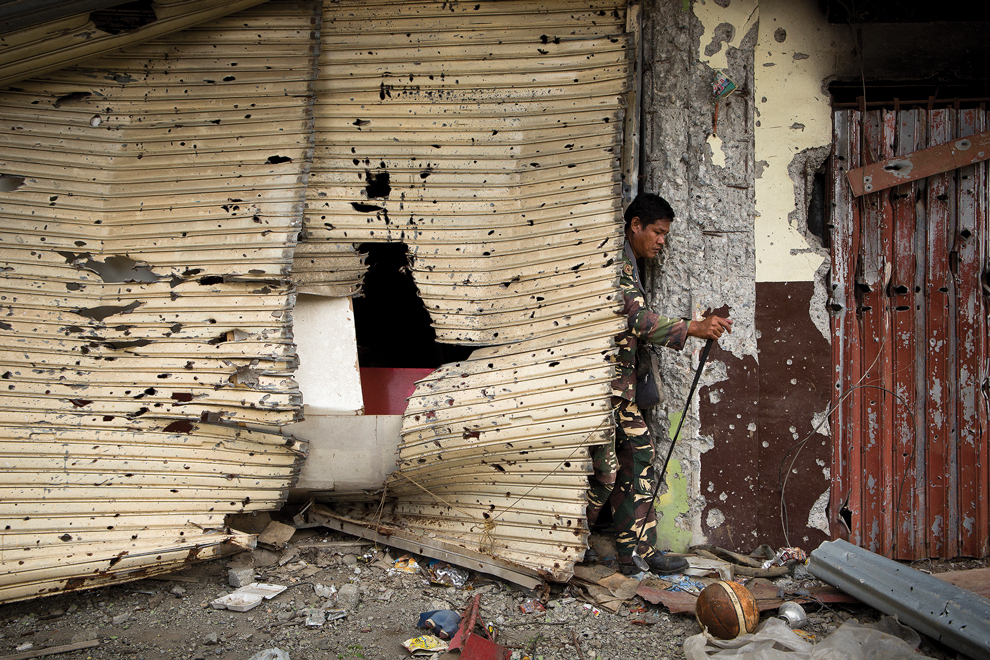
A bullet-riddled storefront in Marawi.
David Maurice Smith
Experts point out that IDPs are particularly vulnerable for radicalization, and some have defected to the insurgency, though given the security situation, it’s impossible to say exactly how many Mindanao youths have done so. Whatever the statistics, extremist groups “are offering a large amount of money to join, regardless of the consequences,” says Hannah Manaligod, a researcher with the Philippine Center for Islam and Democracy. The threat remains especially acute for youths who “think violent extremist groups like the Maute are really fighting for their cause. Those kids are much more receptive to feelings of oppression and marginalization, and it’s not that difficult to imagine [how] they could be influenced by people with certain extreme agendas that they want to push.”
Conditions at the camp were horrendous—families and kids crouched in squalor, bored, sleeping on concrete floors, without enough food or medicine, unable to return to homes that the army had blown to rubble. Yusop, the young woman who had encountered Maute child soldiers in Marawi, told me that the prospects for radicalization among IDPs like herself were scant—if ISIS comes back, she said, her eyes hardening, “the IDPs will be the ones to fight” them.
But as we left the camp, I thought again about the rumors of surviving ISIS fighters patrolling the countryside, offering money to anyone who would join them.
At the jail in Manila, I got as close as the gates, painted an incongruous fuchsia, before nervous guards ushered me away. On the recommendation of his lawyers, Salic had declined my request for an interview, for fear of antagonizing the US and Philippine governments; from the other side of the walls, I could see prisoners inside in orange but couldn’t pick out Salic’s chubby build.
He is facing two sets of charges: from the Philippine government for his alleged role in the sawmill beheadings, and from the United States for his role in financing the attempted attack on New York. Evidence against Salic includes the Western Union deposits to the undercover FBI agent and extensive communications, but he claims to have been entrapped: The undercover agent had badgered him so intensely for a contribution that Salic paid only to get the guy to “stop pestering him,” his lawyer claims, “about talks of violence and extremism.”
If Salic’s struggle to avoid extradition fails, he will end up where Bahnasawy is: in a New York correctional center. Bahnasawy pleaded guilty and is currently awaiting sentencing. In an attempt to get a lenient term—seven years and a transfer back to Canada followed by a release into rehab, rather than life in prison—his lawyers have attempted to show that he was entrapped by the FBI and is mentally disturbed. They have a tough case. After five months of detention, he broke open a pen and used the ink to etch pro-ISIS drawings on the walls. One, in a childlike scrawl, read, “PLEDGE Alliance to ISIS/Spread the Islamic State/Fight the Tyrants/Purify the Earth From Corruption.” Another, above what appeared to be a plane flying into the Twin Towers, said, “FUCK America/Kill Kuffar/End Corruption.” A third had a list of terrorist attacks—“9/11,” “Boston Bombers,” “San Bernardino Shooting,” “Brussels Bombing,” “Orlando Shooting,” and “Manhattan Bombing”—encircled, in a detail reminiscent of Marawi graffiti, with a heart; outside the heart, Bahnasawy had written, “and more coming…”
But his family argues that this was less a sign of his fanaticism than it was of his deteriorating mental health. He scrawled the graffiti after testing positive for contraband drugs that he got in detention, and while locked up, he attempted suicide twice. In a long letter to the judge, filed on March 2, 2018, more than a year after his guilty plea, Bahnasawy describes a stint in solitary: “It was unbearable mental torture for me to have no human contact 24 hours a day, with no one to see or talk to. I knew other jihadist cases were kept like that for years and years; some decades, and I couldn’t imagine surviving that long.” He claimed a guard had bragged of killing and raping Muslims and taunted him by “flipping my food to the ground when giving it through the slot, or [giving] me trays with no food in them.” In one alleged incident, his supposed tormentor brought him to a holding cell and forced him to strip and stand naked against the wall, telling him, “No one’s gonna get you out of jail, not your lawyer, not your family, and not even your prosecutor. You will rot and die in jail.” When he returned, his belongings were scattered across his cell, his Koran ripped up and in the garbage.
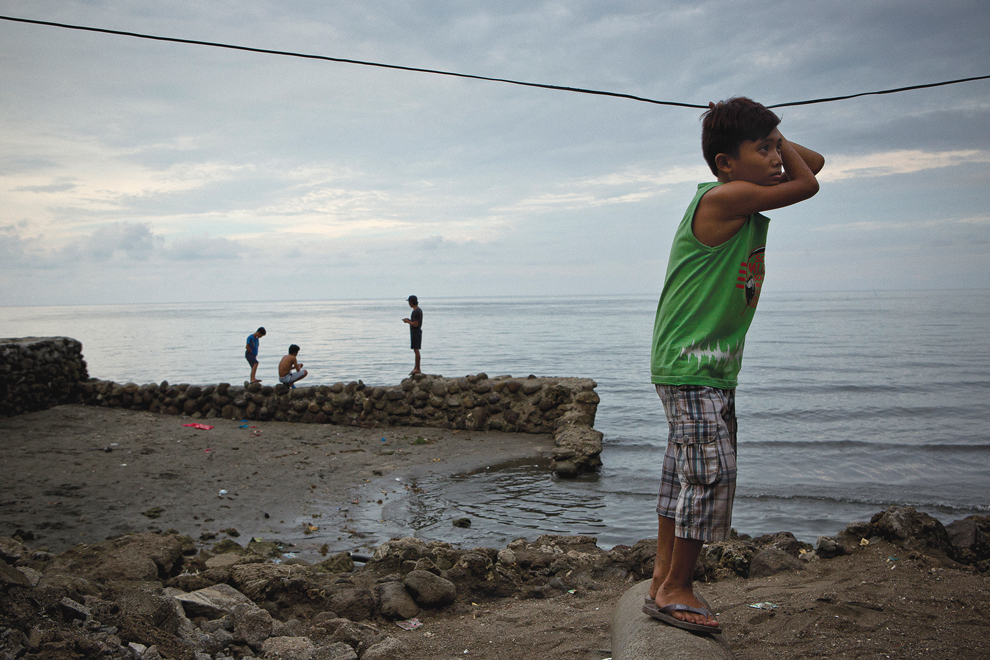
An 8-year-old boy stands near the ocean in Iligan City. He has lived there with his three siblings and parents since May 26, 2017, when fighting broke out in his home of Marawi.
David Maurice Smith
Since coming back to general population, he has earned his GED certificate and is working as a tutor for other prisoners. He’s on medication to treat his bipolar disorder and schizophrenia, and he claims to no longer support ISIS or violent jihad. “I can finally say that I do not want to take the path of violence or war anymore, and that I want to live a good life away from problems,” he wrote to the judge. “I want to experience life away from drugs and away from war and violence. I want a stable life and I want to stop having extreme turns…like my turn towards drugs or my turn towards jihad.” He finished his letter with an impassioned plea to the judge to accept Islam.
Haroon, meanwhile, still sits in jail in Pakistan—like Salic, he is fighting extradition to the United States, where his father has argued he would be endangered because of Trump’s “biased and prejudiced policy against the Muslims.”
An ocean, a continent, and a world of experience and privilege separate Bahnasawy and Haroon from the young militants in the Philippines who filled out the ranks of the Maute army or who may still join it yet, or a like-minded group, in months to come. But they are as similar in as many ways as they are dissimilar: all part of the campaign of global jihad, which promised them glory and brotherhood, a short vibrant life and a meaningful death; all radicalized and steered toward the battlefield by adults eager to use them. By smartphone, by computer, by powerful preachers, they were primed to kill right under their parents’ noses.
Before I left the Philippines, in the shattered outlying neighborhoods of Marawi, I met an assistant school superintendent who had kept the lights on and the kids in class for five months while bombs hit downtown and stray bullets pinged off the schoolhouse walls. Now she was struggling to get students back into school as soon as possible, seeing a prophylactic against radicalism in anti-trauma classes and public education. She was doubly anxious because she had children of her own. “Our kids are very vulnerable,” she said. On Facebook, after the Philippine army took back the city, she had seen photos of young jihadi rebels killed in the fighting. All she could think when she looked at the faces of the young corpses, she said, was that they could have been her sons.
This story was made possible by the Pulitzer Center on Crisis Reporting.
